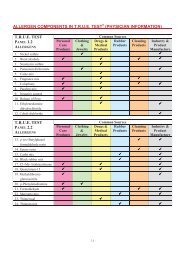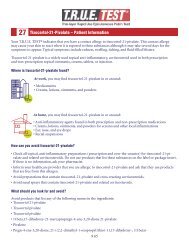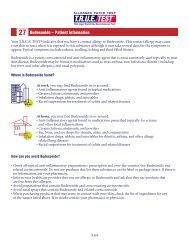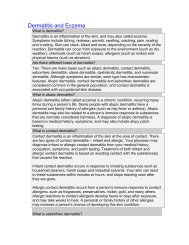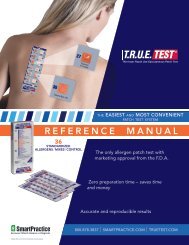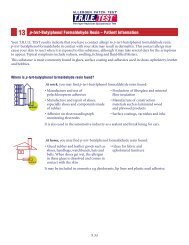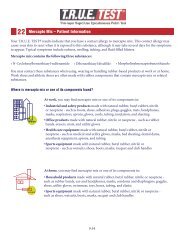2013 Re: T.R.U.E Test and gold Dear Health Care Professional ...
2013 Re: T.R.U.E Test and gold Dear Health Care Professional ...
2013 Re: T.R.U.E Test and gold Dear Health Care Professional ...
You also want an ePaper? Increase the reach of your titles
YUMPU automatically turns print PDFs into web optimized ePapers that Google loves.
It is well established that a contact allergic reaction to the <strong>gold</strong> salt, <strong>gold</strong> sodium thiosulfate (GST), is morecommon than allergic contact dermatitis to elemental <strong>gold</strong> or its alloys. So such a response is not surprising. Infact, these findings have generated considerable controversy about the clinical relevancy of <strong>gold</strong> as an allergen.As discussed in the previous questions, however, support for the clinical relevance of <strong>gold</strong> continues toincrease.Furthermore, sensitivity to <strong>gold</strong> as metal can be overlooked. <strong>Care</strong>ful questioning of patients may yield clues thatsupport the presence of a <strong>gold</strong> allergy. The body sites most likely to be involved are fingers <strong>and</strong> earlobe.Provocation by an intramuscular injection of <strong>gold</strong> sodium thiomalate has even been associated with a flare up ofallergic contact dermatitis from a <strong>gold</strong> necklace previously worn around the neck. As with any allergen, manycomplicated factors are involved in interpreting patch test reactions to <strong>gold</strong>. Nonetheless, the American ContactDermatitis Society has noted that patch testing to <strong>gold</strong> may be particularly worthwhile in individuals withfacial/eyelid dermatitis <strong>and</strong> in those with long-term oral <strong>gold</strong> exposure.Is it normal for a high percentage of patients to test positive to <strong>gold</strong>?Yes. In a carefully conducted, blinded, dose-response clinical trial, about 35% of patients had mild to moderatepersistent reactions to <strong>gold</strong> sodium thiosulfate (GST) that included erythema <strong>and</strong> infiltration (most common),pruritus, <strong>and</strong> hyper- <strong>and</strong> hypopigmentation. In the literature rates of positive reactions to <strong>gold</strong> have ranged fromless than 10% to more than 70%. Consequently, it is reasonable to expect that many patients will have apositive response to patch testing with GST.However, not all reactions to GST may be clinically relevant. As with any allergen, the clinical relevance of areaction to <strong>gold</strong> for any given patient must be assessed by the clinician. Strategies for establishing clinicalrelevance include careful questioning of the patient to determine past <strong>and</strong> present reactions <strong>and</strong> exposures (i.e.,occupational <strong>and</strong> nonoccupational) to the allergen as well as further testing as deemed necessary.Is the concentration of <strong>gold</strong> in T.R.U.E./TRUE <strong>Test</strong> too strong?No. T.R.U.E./TRUE TEST is designed to optimize exposure of allergens to skin for reproducible <strong>and</strong> consistentresults with few irritant or false positive reactions. T.R.U.E./TRUE TEST is currently the only allergen patchtest approved by governmental authorities in both the United States <strong>and</strong> Europe. For example, to qualify forFDA approval in the United States, the dose of <strong>gold</strong> sodium thiosulfate (GST) used in T.R.U.E./TRUE <strong>Test</strong> hadto be determined in a carefully conducted, blinded, dose-response study of patients with a known sensitivity tothe allergen.These patients were patched tested for 48 hours to 6 different doses of GST. The doses were selected based onrecommendations from leading international dermatologists <strong>and</strong> on the concentrations used in othercommercially available preparations. These other commercial products use concentrations of 0.5 or 2.0%,which correspond to concentrations in T.R.U.E./TRUE <strong>Test</strong> of about 0.020 or 0.080 mg/cm 2 . <strong>Re</strong>actions wereread according to recommendations from the International Contact Dermatitis Group.The dose selected for use in T.R.U.E./TRUE test (75 mcg/cm 2 ) met the established criteria of being the lowestconcentration to elicit a +1 or +2 positive reaction in 70 to 90% of the sensitive subjects. Furthermore, theconcordance (percent agreement) between the T.R.U.E./TRUE <strong>Test</strong> allergen <strong>and</strong> the reference allergen insensitive patients was more than 84%, further supporting the appropriateness of the concentration.2



